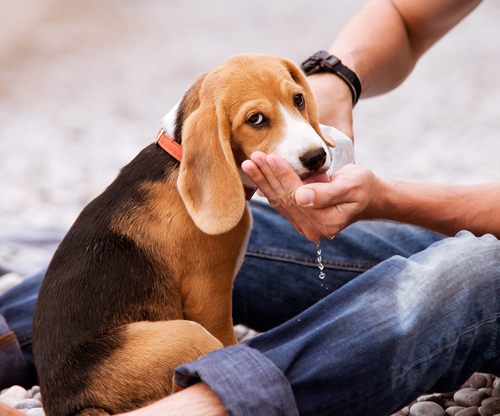It is not an empty statement when they say that dog is man’s best friend.
Since the time when we were still living in caves and hunting with stones, dogs were there to help us with the senses we lack. Now, when most dogs serve only for companionship, there are still some dogs that make human life easier, these are the service guide dogs.
Granted, they are as cute as their pet brethren, but always remember that they are on the job, and that you should pet neither humans nor animals while they are working.
Because of the utter cuteness of these furry helpers we tend to forget the important role they are playing in society. While for some dogs can be good companions and a source of joy, for those who need guide dogs they are an essential part of their life and something they wouldn’t be able to function as well without.
If you, or someone close to you, is in need of a guide dog, there are several factors to consider. Above all else, a guide dog is not a device but a living being, and it is paramount that your four legged helper is a dog that is compatible with your needs and your means.
Contents
Factors to Consider before Choosing a Guide Dog
Infographic by clippersireland.ie.
Nothing beats the idea of having an intelligent and adorable canine companion that possesses nothing but admirable qualities. However, the question is, what should you consider when it comes to getting a guide dog? While some things are the same as when selecting a family dog, there are a couple of differences for guide dogs that need to be noted if you want to be certain that they will improve your life.
Breed
The kind of guide dog you go for depends on the temperaments and train ability for each breed. It is vital to know the qualities possessed by a particular breed so that you can make an informed decision on which would be the best fit.
Breeds like Golden Retrievers are chosen due to their sensitivity and tolerance, while others like Labrador Retrievers are selected due to their good size range, short coat, as well as being generally healthy and with a willing temperament.
Price
Due to all the selection, training, and the relatively small number of puppies that finally become guide dogs, the price for one can be breathtaking, usually passing the cost of a new luxury sedan. While this cost might sound to be unreasonable to many, the increase in productivity for those who need the dog will often be well worth the initial dent in their pocket.
Commitment
Before buying a guide dog, it’s very vital to put into consideration the time and dedication the dog will require. It will need attention, routine veterinary services, training, grooming, and daily care for the rest of its life. This should not be taken lightly, as it is a big commitment.
A dog needs to get the care that it requires and this too calls for more financial expenses. Just as a person would consider their circumstances and lifestyle prior to starting a family, a dog will also impact your daily activities.
Other Pets
Despite dogs being somewhat independent and can be on their own and amuse themselves for short periods of time, being lonely can be detrimental to both their mental and physical health. While the owner might leave the dog on its own while they go to work, the dog might get bored, and this can lead to change in their behavior.
In fact, eventually, it could lead the dog into becoming anti-social. Therefore, it’s critical to have other pets at home that will keep the dog company, preferably other dogs.
Family Set-up
These service dogs, also known as eye dogs, are not the same as having a pet, which means you cannot depend on children to take care of them. They will need an adult to take care of their daily needs. Consider all family members while contemplating buying a guide dog. You should make the adjustments that will make the dog fit into the environment and the family as a whole with ease.
The guide dog movement started after World War II as a way to offer guidance to blinded soldiers. After witnessing a fantastic guide dog program while studying at the University of New England, Arnold Cook became the first person to bring guide dogs to Australia, the first one being a dog called Beau.Beau became famous for touring every state to garner support for the Guide Dog movement with his handler Elsie Mead.
Frequently Asked Questions about Guide Dogs
[learn_more caption=”What are Guide Dogs?”]A guide dog is a specially trained dog meant to assist a visually impaired person. They can lead people safely and effortlessly through their daily activities. Having a sensory impairment becomes less stressful this way, as guide dogs will help you to find your way to and from home, work, school, and everywhere else you wish to go.[/learn_more]
[learn_more caption=”How and Where Are Guide Dogs Trained?”]Guide dogs get training either in a special school or by their owners. Regardless of the trainer and the venue, the bottom line is, they must know how to lead a person. Safety of the owner around obstacles is the key. Depending on the training, owners also have an obligation to understand how to give commands to the dog when moving up and about, especially in unfamiliar areas.[/learn_more]
[learn_more caption=”Which Breeds are Best Suited as Guide Dogs?”]This depends on individuals. However, considering some people are allergic to dogs, you need to get a breed that suits your needs and is not damaging to your health. When choosing a guide dog, it is necessary to select a kind that is the right fit for you. From the large variety of guide dogs, those that are a good fit for most people include labradors, golden retrievers, German shepherds, poodles, Labrador retrievers, and Labradoodles.
For those who are allergic to dogs,poodles and Labradoodles are the best breeds. These dogs are excellent in health qualities, temperament, intelligence, and other qualities that make a good guide dog. Their limited shedding and light coat makes them a good choice for people with allergies.[/learn_more]
[learn_more caption=”How Much Does a Guide Dog Cost?”]The topic of cost for these service animals will startle most people. A guide dog costs between $40,000–$60,000. However, if you break down what and why the dog is this expensive, you may agree that this amount is reasonable.
The initial price for such a dog is between $30,000 and $50,000, depending on the training requirements and general disposition of the dog. The top range will only be for dogs that need daily training and are meant for the most demanding tasks. Additionally, the cost of having the seassistance dogs is around $1,200 per year, with the span of the dog’s service being eight years. Using this calculation, we can see how the price can reach the top of the aforementioned range, but those who want to pay less will always have the choice of training the dog themselves, significantly reducing the overall costs.[/learn_more]
[learn_more caption=”How Do Guide Dogs Know Where to Go When Traveling?”]This is a combined effort between the owner and the dog. The owner knows where they want to be and the specific place where they want to go. This means that it is the owner’s responsibility to communicate to the dog where they want to be guided using either hand signals or verbal cues. The direction advice that the dog will give to the owner includes forward, right and left. When crossing the road, it is the responsibility of the owner to command the dog on when to cross, using their own judgment. This depends on the noise of the cars, which aids in determining the safest place to pass. However, as said earlier, the dogs will exercise intelligent disobedience when they feel it is unsafe to obey the command.[/learn_more]
[learn_more caption=”Do People Need to be Completely Blind to Have a Dog Guide?”]You don’t have to be entirely blind to have a guide dog. People legally proven to be blind but still have some vision can still benefit from the services of a guide dog.[/learn_more]
[learn_more caption=”How Long it Takes to Train a Guide Dog?”]If you ever thought a dog is too young to start training, it’s good to know that guide dogs begin their training at day one. At this tender age, the veterinary staff handles them. By week eight, the dog has socialized with people, as well as familiarized itself with surfaces and other dogs. The guide dogs are then taken to their trainer’s homes and keep living with them until they’re 14–16 months. This depends on the dog, as some learn and mature faster compared to others. They go back to the formal training school for three to four months after which they are ready to start their job. In short, the dog takes a maximum of two years to complete their training.[/learn_more]
[learn_more caption=”Is it OK to Pet or Feed the Dog Guide while it is Working?”]Understanding the nature of the guide dog is vital. It’s important to remember that not every animal is capable of multitasking. If you feed the guide while they are working, you might be risking the life of its owner. The dog can focus on food and forget its core duty of guiding. Never pet the guide dog without the consent of its owner, especially while working. Always seek confirmation and ask whether it is okay to do so.
Ideally, a guide dog should never be distracted. The owner’s safety and well-being may depend on the dog’s concentration and alertness. Disrupting it through a call, petting or intentionally obstructing its paths might alter its focus and can be detrimental to the work they are doing.[/learn_more]
[learn_more caption=”Can Guide Dogs Read Signs?”]Guide dogs are trained to go from curb to curb. Unfortunately, guide dogs don’t read signs. It is the responsibility of the owner to command the dog where they want to go. The good thing is that if the dog is used to taking you to a specific location, they will remember the path and take you to the right place every time.[/learn_more]
Guide Dog Health Risks
Some diseases can be fatal for a dog. This calls for regular vaccinations as to complete the healthcare program. Vaccinations mostly help in the prevention of spread and treatment of infectious diseases. Injections used should contain a weakened form of the organism that the dog needs protection from. Some major viruses that the dog needs a vaccine to prevent include:
Parvovirus
Parvovirus is extremely infectious viral disease mostly attacks young dogs. However, dogs of all ages can be infected. It causes inflammation of the dog’s intestines leading to severe stomach issues and dehydration. The heart can also become inflamed in young puppies.
This virus has proved stubborn in the environment, which means it can survive for many months outside the animal’s body. Just as the saying goes, prevention is better than cure. Vaccinate your dog and make it protected against parvovirus.
Distemper
This is a highly contagious viral disease. With myriad symptoms, the most obvious sign of this disease is sneezing, coughing, and unpleasant eyes and nasal discharge. When advanced, it causes paralysis in the dog. Don’t wait until your dog has succumbed to this. Frequent vaccination will work it out; therefore, ensure you vaccinate your dog for good, better and improved performance.
Hepatitis
This viral disease spreads by direct dog-to-dog contact through saliva, urine, and feces. The liver is the target organ of this disease, and once the dog is infected, the liver is enlarged and is inflamed. The virus may also damage the kidneys and eyes.
Dogs that are recovering from the disease may continue to harbor the virus and act as carriers, spreading the disease to other dogs by direct contact. If you like a dog that will give you a service while still in good health, why wait until it succumbs to this monster disease? Vaccinate as early as today.
Leptospirosis
This disease has different strains of Leptospira that can infect the kidneys and liver of a susceptible dog.Leptospirosis organisms thrive well in ponds, streams, and rivers and transmit by direct dog-to-dog contact. It’s unfortunate that a strain of this disease can be passed on to a person which is why it is so important to vaccinate the dog regularly.
Recommendations
To ensure the good health of your guide dog, give the dog immunity boosters as soon as possible.The veterinary surgeon should administer the boosters at an interval recommended by the manufacturer. This will aid in boosting the immunity and defense against diseases.
Neutering
This is the removal of the dog’s reproductive organs. It helps in preventing unwanted litters.In female dogs, the procedure is called spaying, and with male dogs, it is called castration. Working guide dogs need to keep their mind and concentration on the job.
If the reproductive organs are retained, there is a possibility that they will be distracted by their mate in season and sneak away to find them.Therefore, it is important that all guide dogs are neutered except for the breeding dogs, as to avoid eventualities that can put the owner into danger.
Removal of Parasites
It is important to know when your dog has an infection or parasites. The most common dog parasites are ticks and fleas.If there are few fleas present, the flea dirt may be the only evidence and will appear as small, black specks. Some dogs might be tolerant to flea bites and endure them with just a little bit of scratching.
However, most dogs will show a very severe reaction from both the fleabite itself and the insect’s saliva.To confirm the presence of fleas, place some flea dirt on a wet piece of cotton wool. The dust will turn red as the blood pigment dissolves.
To control fleas, you must treat all your cats, dogs, and all other pets on the same day. Treatments for your dog are readily available in every pet store as well as online. Some products might act immediately while others take some time to achieve the desired impact.
Don’t wait for your dog to get parasites; treat your dog at regular intervals according to the manufactures guide.
Microchipping
This is the main dog identification method. Microchip identification was introduced in the late ’80s and has gained popularity over time. It has gradually been accepted as a safe and reliable way to identify dogs.
Diet
Feeding your dog with the best quality food that meets their dietary needs is one way to ensure it stays healthy. A complete diet for your dog should contain allingredients required to maintain your dog’s health, muscle mass, and active behavior.There are puppy foods, adult maintenance foods, and foods suitable for older dogs. Other types of food are available as well, such as tinned meat and mixer biscuits.
Whether you are using tinned dog food or other types of food, the main goal is to observe the amount of food the dog gets.
Do not feed titbits or home-cooked rations as this may lead to nutritional imbalances.It is recommended not give bones to your guide dog due to the potential damage that can occur on teeth and mouth.Bones may cause minor stomach upsets and splinters can become stuck in the digestive tract leading to larger problems.
Eye and Ear Care
Occasionally some minor objects can get into the dog’s eye and cause inflammation and can sometimes lead to an infection. Other problems that require regular checks are eyelid problems, dry eyelids, or glaucoma. Regularly take your dog to a veterinarian. This also helps in avoiding worsening conditions, which might cause permanent damage to the dog’s eyesight.
Washing
This is part of the pet’s care and health program. Regular baths help in removing bad smells and odors that the dog picks from the environment. The obvious benefits of bathing your dog include cleaning the skin and coat, which helps to remove scale, loose hair and debris and improve the shine of the hair coat.
Bathing may be part of their medical treatment plan as recommended for dogs with specific skin conditions by their vet. You should make sure not to wash the dog too often as it is both unnecessary and can be damaging, as well as to always use shampoo that is made for dogs. Regular cleaning products can damage the dog’s skin and fur.
Treatment of Injuries
Often, your dog might succumb to injuries due to unavoidable circumstances. It is crucial to understand how you should undertake the therapy to avoid further damage to the dog. Here is the procedure on how to treat an injury:
- Place a clean towel over the injured area to stop any bleeding.
- Keep the injured part of the body elevated.
- Wash the affected area carefully.
- Tie a sterile bandage over the wounded area.
- Apply an antibiotic ointment to the wounded area daily to prevent infections.
Wrapping Up
Having a guide dog is incredibly helpful as to cater to your needs, especially for people with vision loss. However, it can turn out to be very inconvenient if the dog turns out to be unfit to do their job due to lack of care or bad training.
Although it is hard to imagine that you will not like a dog, it is important to remember that a guide dog is not only a pet, but also a crucial aid to your daily life, and should be selected with the same clear head and specification as you would hire a person.
If you choose a dog that is a good match for your wants and needs, you will not only gain an excellent assistant to guide you around but will also get your best friend that will give you undying love and loyalty.
I grew up in a household that was filled with animals. I believe that my fate as a dog-loving person was sealed in early childhood since my parents owned several dogs of varying sizes and breeds. There was no choice but to take care of and learn about dog habits and the best animal care practices — otherwise, I’d be clueless about how to go about the creatures I was surrounded by day and night.
As a life-long puppy lover, I know a thing or two about dogs and how to go about caring for them in the best way possible. Although I’m not a professionally trained dog behaviorist, trainer, or veterinarian, all of my knowledge and experience with canines comes from a place of love and a deep-rooted passion for dogs and animals in general.
Seeing as dogs kept me company throughout every stage of my life, I decided to follow a different path in my academic life and obtained a Bachelor’s and Master’s degrees in Marketing Management and Digital Advertising, which ultimately allowed me to combine my professional training and personal experience by creating the ultimate dog lover’s resource website! Along with my husband, Dave, I run MySweetPuppy for like-minded dog lovers who want to have a single, clear, and reliable information source about anything and everything related to dogs and their well-being.







